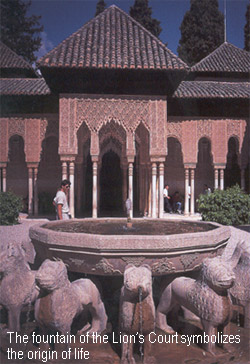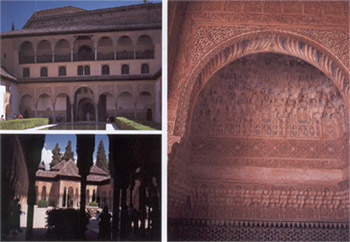|
 The
south-eastern tip of Spain is a hot and
arid place, very similar in its
environment to our rocky deserts of the
UAE. Cut off from the rest of the country
by the Sierra Nevada mountain range, it
has a dry Mediterranean climate. The
vegetation from Almeria inland is sparse
and by the end of the summer everything is
straw-coloured or gray. Driving through
this landscape along the western edge of
the mountains towards Grenada, the sudden
increase in vegetation on the northern
side of the range takes you by surprise.
Then you see on a hill at the foot of the
mountains a fortress with the colour of
dried blood. Originally it had the name
Al-Qal'at al-Hamra, the red city. Now it
is know the world over as the Alhambra,
ancient monument of the Moors.
The
south-eastern tip of Spain is a hot and
arid place, very similar in its
environment to our rocky deserts of the
UAE. Cut off from the rest of the country
by the Sierra Nevada mountain range, it
has a dry Mediterranean climate. The
vegetation from Almeria inland is sparse
and by the end of the summer everything is
straw-coloured or gray. Driving through
this landscape along the western edge of
the mountains towards Grenada, the sudden
increase in vegetation on the northern
side of the range takes you by surprise.
Then you see on a hill at the foot of the
mountains a fortress with the colour of
dried blood. Originally it had the name
Al-Qal'at al-Hamra, the red city. Now it
is know the world over as the Alhambra,
ancient monument of the Moors.
When you
visit the Alhambra you enter another
world. "It is an island surrounded by red
and ochre walls, suspended in the sky and
leaning against the snow-topped
mountains".
The
fortress is host to various gardens and
palaces in different styles, with
influences from the ancient Berbers, from
the Jewish employees of the Sultans, and
from Persia.
The
first palace was constructed in the 11th
Century by Samuel Ibn Najrellah, a Jewish
viceroy of a Berber King, in a time when
there was no enmity between the two
peoples. Other parts were created by the
last Sultan of Andalousia in the 13th
Century. The princes of the Nasri dynasty
created the heavenly gardens that evoke
paradise.
In 1236
the Catholic Rulers of Spain recaptured
Cordoba from the Moors, who had occupied
the land for several centuries. Seville
fell ten years later. Those Moslims that
did not flee to the Maghreb or Egypt,
sought refuge in Grenada. Yusuf Ibn Nasr,
the founder of the Nasri dynasty had made
Grenada the capital of an emirate that
stretched from Almeria to Gibraltar. For
260 years, Grenada, a city of fine arts
and silk production, remained one of the
most powerful cities of Medieval Europe.
It was
the civil war at the beginning of the 15th
century that sounded the death knell for
Grenada as a Moorish stronghold. The
Alhambra held out till 1492 when Boabdil,
son of Abu al-Hassan, gave the keys of the
city to Ferdinand and Isabelle, Catholic
rulers of Spain. The Alhambra was by then
so famous for its symphony of palaces,
trees and flowers, bathed in water and
light, a mystical utopia, that the
conquerors never dared to destroy it as
they had Seville and Cordoba.
The walk
through the gardens, courtyards and
palaces of the Alhambra is even now,
almost 8 centuries after its construction,
a magical experience. One of the experts
that have made the Alhambra the subject of
his research says that "the Alhambra does
not really exist, it is a space to be
created by yourself, with your
sensitivity, your knowledge and your
imagination". And this is true in a sense.
Every person that walks through the
gardens, along the waterways and under the
trees and arches of this magical place
will create his own image of heaven here.
First there is a strictly Islamic garden,
reproduction of the Garden of Allah, where
large trees cast their shadow over rivers
of pure water. This shows especially in
the upper terraces of the Generalife, the
main palace, where a staircase of water
cascades down to the romantic Mirador
pond. An ingenious system of capturing and
distributing water from the nearby
mountains, probably very similar to the
present-day Arabic "aflaj" system, is
still intact. The Generalife itself is
located at the highest spot on the Cerro
del Sol, the Hill of the Sun. Its arched
and extravagantly decorated rooms look out
over the Patio de l'Acegia. Originally it
did not really belong to the Alhambra
complex property. It used to be the place
where the sultans withdrew for their
private rest and recreation. The gardens
that border the central ponds were first
designed by the French during their
occupation of Grenada in the 19th century.
(The French did more than designing the
gardens - in 1812 they blew up seven of
the original towers of the complex, and it
was only the action of a Spanish soldier,
who cut the fuses, that no more damage was
done).

The
gardens were recreated between 1931 and
1951, this time to contain the type of
sweet-scented plants favoured by the Nasri
Sultans: roses, sage, oranges, rosemary,
and carnations.
Then
there is the Arrayane patio, the courtyard
of myrtles, in the Iranian style such as
inspired the Omayyad and Abbassid
architecture of Damascus and Baghdad,
where palaces are mirrored in large ponds,
bordered with flowering and fruiting
plants. In the Alhambra, the oldest
building is mirrored perfectly in the
still pond, and the upside down image
below the actual building gives the
impression that all is suspended in air.
The most
famous is the Courtyard of the Lions with
its 24 columns of marble, its rooms with
ceilings worked like lace, its floral
frescoes and Arabic calligraphy, sculpted
in stucco, like petrified poems. The
arched ceilings between the columns recall
the cave where the prophet Mohammed
received his revelation of the Quran.
This
courtyard was originally called "Al riad
al-sa'eed" - the Happy Garden. In the 14th
century the corners between the irrigation
channels used to be covered with low
vegetation, hiding the base of the columns
and in this way giving the impression of a
real forest. In the whole Islamic world
there is not one place that comes so close
to the Quranic vision of the Gardens of
Paradise!
Its four
narrow water channels symbolize the 4 holy
rivers, the fountain symbolizes the origin
of life; the stone is the eternity and the
marble columns - the forest. It is a
petrified garden of Eden with the
perpetual movement of the water and the
strict symmetry of all its elements.
Off to
one side is the "Hall of the Two Sisters",
where the Sultan's favourite wives lived.
Close by was the "Gossip room", the
factory of intrigues that housed the rest
of the harem that was guarded by eunuchs.
In the
great "Hall of Kings" entertainment was
provided for residents and visitors.
These palaces
were built with very simple materials:
bricks and uncut stones held together by
mortar of chalk and iron-rich soil, that
gives it the red color. It is an ideal
fusion of architecture and nature, of
buildings and gardens; in such a way that
it is difficult to tell where one ends and
the other begins. Its subtle harmony grows
on you as you lose yourself in the maze of
walkways.
The
Alhambra is the fruit of a coming together
of various cultures - a door to the golden
age of Islamic art. The scientists who
study the complex are continuously
discovering new aspects. Only recently did
someone notice that the lionís statues in
the Court of the Lions are not all the
same size. It turned out that six depicted
males and the other six were females. The
thousands of Arabic verses that are
inscribed on the walls of the buildings
have not all been inventoried, leave alone
deciphered.
One of
the Spanish Alhambra experts, Jose Miguel
Puerta, sums up his feelings for the
Alhambra:
"A solitary, holy space, place of infinite
pleasure, of fertility, of eternity, on
this hill close to the stars, turned
towards God in the hope to merge with Him,
for ever. All of that is there, in the red
fortress, the Alhambra."
|
